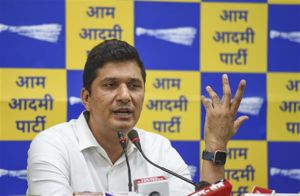
Haryana has started a slew of projects to boost tourism in Lohgarh. Tribune photo
Shiv Kumar Sharma In Yamunanagar
History can be a queer treasure trove of unencumbered doubts and self-assured glorification: the two may tend to meet at even queerer juncture of folk tales and beliefs. Like Lohgarh fort, lying on the cusp of Haryana and Himachal Pradesh. The fort, believed to be the largest in the world, has lived off the terrain, steel-like, unforgettable for generations, unsought for, yet standing apart rock solid. What was there, and is there, has remained unnoticed for 300 years — this is its claim to fame, with the belief that the decaying fort was once witness to three battles between Baba Banda Singh Bahadur’s forces and Mughal armies.
Lohgarh came into limelight when the Haryana government held a state-level function to celebrate the 300th martyrdom of Banda Bahadur last year. The chief guest, chief minister Manohar Lal Khattar, highlighted several “untouched historical facts” about the place and told the gathering that his ancestors were also a part of the Banda Bahadur’s army. The state government is keen to develop Lohgarh, of which a part exits in Bhagwanpur gram panchayat of Yamunanagar district and the other part in Himachal Pradesh.
Lohgarh is located about 35 km from Yamunanagar. The state government appointed district development and panchayat officer (DDPO) Gagandeep Singh a nodal officer to develop the area. A Sikh activist, Jarnail Singh, says the community has formed ‘The Lohgarh Trust’ under the chairmanship of Gurvinder Singh, a resident of Karnal, for carrying out research about the place and the fort. The trust has roped in a Delhi-based heritage revival company, the Indian Trust for Rural Heritage and Development (ITRHD).
The ITRHD research about Lohgarh has revealed that the Lohgarh fort included fort walls, bastions, rooms, soldier barracks, watch towers, pottery, grindstone, hand milers to mill floor and big clay drums for the storage of food grains. Many carved stones are also found. “The fort walls are made of dressed stones and lime. Mortar mixed with brick powder has been used as the binding material. The bricks used in the fort walls are of five different sizes,” says SK Mishra, ITRHD chairman. Archeological studies have thrown up astonishing facts, he said.
Gagandeep Singh, the nodal officer, says Lohgarh was Khalsa Rajdhani and the epicenter of its fort was spread across 7,000 acres, making it of one the largest forts in the world. The fort area covers revenue estates of Haripur, Jhil, Mehtawali, Palori, Sukron, Maharonwala (in HP), and Bhagwanpur, Nathori, Dhanaura, Nagli and Mohindinpur (in Haryana).
“The 52 defence posts (bastions) built by the Banjara Sikhs in plains before the Lohgarh fort to check the advancement of the Mughal army extended up to Ladwa (part of Kurukshetra) and Indri of Karnal,” says Gagandeep. “It is interesting to note that the Lohgarh fort was constructed by the general public and not by a monarch.”
Dr Harjinder Singh Dilgeer, former director Sikh History Research, SGPC, and former visiting professor Punjabi University, Patiala, says Bhai Lakhi Rai Banjara, Bhai Makhan Shah Labana (rich traders) and Peer Budhu Shah (a noble man in the Mughal court) played a key role in raising funds for the construction of the fort.
He said that in 1708 AD, after a series of talks failed between Guru Gobind Singh and Bahadur Shah at Nander (Maharashtra), Baba Banda Singh Bahadur, the first Sikh general was deputed by the 10th master to uproot the Mughal empire. “In 1709, Baba Banda Singh Bahadur, after capturing all the major parts of Delhi and Lahore declared Lohgarh as Khalsa Rajdhani,” said Dr Dilgeer. He says first Khalsa Raj coins were minted, the Sikh calendar was issued and a royal seal was prepared to issue ‘farmans’ (orders) by Baba Banda Singh Bahadur.
Dr Dilgeer says historians have wrongly called Lohgarh as Muklishgarh, the Rang Mahal of Mughals situated in UP, close to Hathni Kund Barrage of Yamunanagar district.
Prof Veena Sachdeva of Panjab University, Chandigarh, says three battles were fought at Lohgarh. The first was fought between emperor Bahadur Shah and Baba Banda Singh Bahadur in 1710; the second was fought in 1712 (between emperor Jahandar Shah and Baba Banda Bahadur) and the third battle in 1713 (between Abdus Samad Khan, the Mughal subedar of Lahore appointed by emperor Farrukhsiyer, and Baba Banda Bahadur).



























